|
|
|
Sort Order |
|
|
|
Items / Page
|
|
|
|
|
|
|
| Srl | Item |
| 1 |
ID:
190722
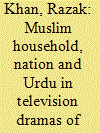

|
|
|
|
|
| Summary/Abstract |
The article explores the genealogies of Muslim cultural and Urdu language reform in late nineteenth century colonial India and traces its post-colonial trajectories in contemporary public culture in Pakistan. It does so by analysing the language and gender politics of Urdu in two Pakistani TV dramas, Aangan Terha (Crooked Courtyard), written by Anwar Maqsood and screened on the government-run Pakistan Television Corporation (PTV) channel in 1984, and Quddusi Sahab ki Bewah (The Widow of Mr. Quddusi), scripted by Faseeh Bari Khan, which was telecast on ARY Digital, a global private satellite channel, in 2012. The article emphasises the gendered language and performative politics of Urdu and respectability in colonial and post-colonial South Asia.
|
|
|
|
|
|
|
|
|
|
|
|
|
|
|
|
| 2 |
ID:
167086
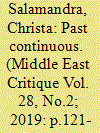

|
|
|
|
|
| Summary/Abstract |
Syria serves as a leading producer of the musalsal [dramatic miniseries], a key Arabic-language mass cultural form. With its dark realism and biting humor, Syrian drama has become a primary mode of sociopolitical commentary for both producers and audiences, given the restrictions on journalistic and academic expression and the absence of participatory politics in most Arab polities. Drama creators deploy a range of temporal strategies to comment on social and political conditions. A reflexive, intertextual chronopolitics runs through serials produced before and during the Syrian conflict that began in 2011. The question ‘what went wrong?’ preoccupies musalsal makers, and their works frequently foreground their belief that Syrian society is ‘going backwards.’ For example, in historical genres of television serials, idealized images harken back to perceived golden ages of cosmopolitanism, throwing the contemporary condition into bitter relief. Makers of dramas set in the present invert this technique, locating the sources of contemporary ills in past mistakes and historical injustices, revealed in flashback, dialogue, and voiceover. Through a technique of narrative allochrony, drama creators also highlight their understanding of modernity’s lapses, depicting select practices, mores, and attitudes as out of sync with what they see as contemporary values. These dramatic depictions of the past and present all point to a failed national project and a derailed modernity. Their creators seek to counter what they deem as a flawed political and social evolution, one that they believe has led to deterioration in the region and a devastating war in Syria.
|
|
|
|
|
|
|
|
|
|
|
|
|
|
|
|
| 3 |
ID:
139303
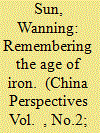

|
|
|
|
|
| Summary/Abstract |
Over the past few years we have witnessed a minor cultural phenomenon in China, with the production and enthusiastic reception nationwide of several television dramas about Chinese workers in the socialist decades. Set in the industrial plants of Liaoning in China’s northeast, once the industrial powerhouse of the socialist nation, these drama series centre on the dramatic transformation in workers’ experiences from 1949 to the start of economic reforms. In this paper I explore these series, asking: what does the smallscale production but enthusiastic reception of this genre tell us about the contemporary cultural politics of class? This paper addresses this question by (1) highlighting the key aspects of workers’ experiences with socialism as depicted in these television narratives; (2) considering the creative agenda of Gao Mantang, the script writer of the most successful industrial-themed television series; and (3) identifying some crucial ways in which the subjectivity of workers and other social groups in contemporary Chinese society intersect to shape the cultural politics of class. This discussion shows that television dramas have indeed become the basis of a widely accessible public forum that helps forge a renewed appreciation of the moral integrity of China’s working class, vent a widespread sense of injustice, and foster a certain degree of solidarity between workers and other social classes. At the same time, while television dramas about workers may hold significant potential for mobilising public support for the working class and advocating workers’ interests, this discussion also suggests that so far this potential has not been fully exploited
|
|
|
|
|
|
|
|
|
|
|
|
|
|
|
|
| 4 |
ID:
167087
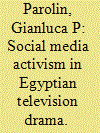

|
|
|
|
|
| Summary/Abstract |
Egyptian Ramadan TV series have explored the relationship between law and television in a number of iterations over the past few years. In 2017, the most watched production (115 million views on YouTube), Kalabsh, went one step further by examining the interaction between television broadcasting and social media in affecting the course of justice. Even though its events revolve around the framing and wrongful incrimination of a ‘good’ police officer, the dynamics suggest a not-so-subtle reference to the January 25, 2011 uprising. It portrayed social media actors as naïve agitators, outsmarted and used by those same dark networks of business and politics that they intend to expose and ultimately to unseat. This representation strengthens the counter-revolution’s narrative of the January 25 uprising as the making of some ‘Facebook kids’ [ʿiyāl bitūʿ il-face]. With Kalabsh, Egyptian TV series recalibrate the representation of the role of television broadcasting in affecting the course of justice and thus produce a new narrative that includes social media. This representation challenges as ‘optimistic’ the reading of the ‘democratic’ nature of social media by showing how its actors are even more prone to falling prey to mystifications and networks of corruption. The centrality of television broadcasting in affecting the course of justice clearly recedes in Kalabsh, but television broadcasting itself seems to regain some reputation.
|
|
|
|
|
|
|
|
|
|
|
|
|
|
|
|
| 5 |
ID:
167088
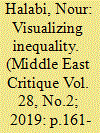

|
|
|
|
|
| Summary/Abstract |
Space has played a central and largely overlooked role in the Syrian conflict during the past eight years. A tension surrounds the organization of urban space and its impact on cultural identity, inequality, and political mobilization. Spatial politics represent a looming threat that is implicit in the project of ISIS, an international terrorist organization that seeks to appropriate the geographical area of al-Sham (Greater Syria) to create a transnational Caliphate. It also appears in the ‘development proposals’ of the Syrian government, which capitalize on a humanitarian crisis to expropriate forcibly displaced citizens of their land and properties.1
1 Signed into law by Syrian President Bashar Al Assad in April 2018, Law number 10 allows the government to seize and redevelop properties in ‘ashwa’iyat or illegal neighborhoods. For more on this see Rania Mostapha (2018Mostapha, R. (2018) Law 10 and the Theft of Syrian Property, Salon Syria. Available at:
https://salonsyria.com/law-10-and-the-theft-of-syrian-property/#.W_s8tPZFxyw
, accessed November 24, 2018.
[Google Scholar]
) Law 10 and the Theft of Syrian Property, in Salon Syria. Available at: https://salonsyria.com/law-10-and-the-theft-of-syrian-property/#.W_s8tPZFxyw, accessed February 4, 2019.
View all notes
This article analyzes how Syrian television drama is not only an important field of cultural expression and a site of contestation but also reveals the many socioeconomic spatial tensions underlying the 2011 Revolution and its aftermath. The latter aspect is demonstrated through a visual and textual analysis of two television serials that depict the ‘ashwa’iyat,2
2 The term ‘ashwa’iyat’ literally translates to ‘arbitraries’ in English, referring to the unregulated, unlicensed and arbitrary fashion in which these slums have been erected and continue to exist. The adjective, in its plural form, has morphed into the common term used to describe the shanty towns surrounding the Damascene urban center.
View all notes
[arbitrary informal settlements of Damascus]. The first show, al-Intizar (2006), aired before the Syrian conflict. The second, Zawal (2016), aired as the political turmoil in Syria continued to unfold. This comparative analysis illustrates how the organization of urban space has impacted the dynamics of the Syrian Revolution and its aftermath, and how portrayals of urban and shanty town dramas portrayed the spatial inequalities of Damascus before and during the conflict.
|
|
|
|
|
|
|
|
|
|
|
|
|
|
|
|
|
|
|
|
|